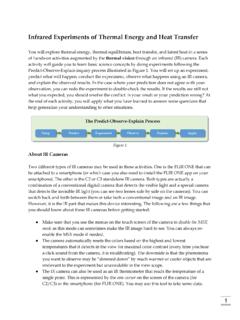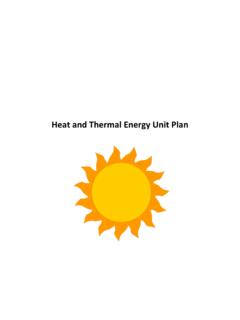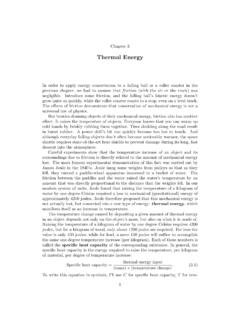Transcription of Thermal Energy Storage Strategies for Commercial HVAC …
1 Copyright May 1997, Pacific Gas and Electric Company, all rights 4/25/97 APPLICATION NOTEAn In-Depth Examination of an EnergyEfficiency TechnologyThermal EnergyStorage Strategiesfor CommercialHVAC SystemsSummaryThermal Energy Storage (TES) systemsshift cooling Energy use to non-peaktimes. They chill Storage media such aswater, ice, or a phase-change materialduring periods of low cooling demandfor use later to meet air-conditioningloads. Operating Strategies are gener-ally classified as either full Storage orpartial Storage , referring to the amountof cooling load transferred from on-peakto systems are applicable in mostcommercial and industrial facilities, butcertain criteria must be met for eco-nomic feasibility.
2 A system can be ap-propriate when maximum cooling load issignificantly higher than average demand charges, and a significantdifferential between on-peak and off-peak rates, also help make TES sys-tems economic. They may also be ap-propriate where more chiller capacity isneeded for an existing system, or whereback-up or redundant cooling capacityis shifting load, TES systems mayalso reduce Energy consumption, de-pending on site-specific design, notablywhere chillers can be operated at fullload during the night. Also, pumpingenergy and fan Energy can be reducedby lowering the temperature of the wa-ter, and therefore the air temperature,affecting the quantity of air costs tend to be higher than aconventional direct-cooling system, butother economic factors can reduce suchcosts.
3 In new construction, This TechnologySaves of Demand and EnergyEfficiency Observations to and Service , Codes, and of Key to More Energy Efficiency Information Thermal Energy Storage Page 2could be smaller, allowing more usablespace. Or a TES system may enablereduction in electrical capacity, reducingthe cost of electrical service for a new orexpanding This TechnologySaves EnergyIn a TES system, a Storage medium ischilled during periods of low coolingdemand, and the stored cooling is usedlater to meet air-conditioning load orprocess cooling system consists of a Storage me-dium in a tank, a packaged chiller orbuilt-up refrigeration system, and inter-connecting piping, pumps, and Storage medium is generally water,ice.
4 Or a phase-change1 material(sometimes called a eutectic salt); it istypically chilled to lower temperaturesthan would be required for direct coolingto keep the Storage tank size withineconomic limits. Figure 1 illustrates thebasic operation of a system that useschilled shifting is typically the main rea-son to install a TES system. Cool stor-age systems can significantly cut oper-ating costs by cooling with cheaper off-peak Energy , and reducing or eliminat-ing on-peak demand systems have a reputation forconsuming more Energy than nonstor-age systems.
5 This has often been truewhere demand reduction was the pri-mary design objective. Cool Storage 1 Bold italicized words are defined in the sectiontitle Definition of Key Terms. does require the chiller to work harderto cool the system down to the requiredlower temperatures (for ice Storage );and Energy is needed to pump fluids inand out of a number of design options canmake TES systems more Energy -efficient than nonstorage systems. Stor-age systems let chillers operate at fullload all night , versus operating at full orpart load during the on the system configuration,the chiller may be smaller than would berequired for direct cooling, allowingsmaller auxiliaries such as cooling-tower fans, condenser water pumps, orcondenser fans.
6 Pumping Energy canbe reduced by increasing the chilledwater temperature range; fan energycan be cut with colder air systems can also make in-creased use of heat recovery and wa-terside economizer LoadDistributionPumpPrimary PumpWarmCoolDischargingChargingStorageFi gure 1: Thermal Energy StorageSystem with Stratified Chilled WaterStorage (Source: ASHRAE)*PG&E Energy Efficiency Information Thermal Energy Storage Page 3 Types of Demand andEnergy Efficiency MeasuresTES systems can be characterized bystorage medium and Storage technol-ogy.
7 Storage media include chilled wa-ter, ice, and phase-change materials,which differ in their operating charac-teristics and physical requirements forstoring Energy . Storage technologiesinclude chilled water tanks, ice systems,and phase-change Water StorageThese systems use the sensible heatcapacity of water (1 Btu per pound perdegree Fahrenheit) to store volume depends on the tempera-ture difference between the water sup-plied from Storage and the water re-turning from the load, and the degree ofseparation between warm and cold wa-ter in the Storage tank.
8 Where mostconventional nonstorage HVAC systemsoperate on temperature differentials of10 to 12 F, chilled water systems gen-erally need a differential of at least 16 Fto keep the Storage tank size reason-able. A difference of 20 F is the practi-cal maximum for most building coolingapplications, although a few systemsexceed 30 water is generally stored at 39 Fto 42 F, temperatures directly compati-ble with most conventional water chillersand distribution systems. Return tem-peratures of 58 to 60 F or higher aredesirable to maximize the tank tem-perature difference and minimize volume is affected by the separa-tion maintained between the stored coldwater and the warm return water.
9 Natu-ral stratification has emerged as thepreferred approach, because of its lowcost and superior performance. Colderwater remains at the bottom andwarmer, lighter water remains at the designed diffusers transferwater into and out of a Storage tank at alow velocity to minimize figure of merit (FOM) is a measureof a tank s ability to maintain such sepa-ration; it indicates the effective percent-age of the total volume that will beavailable to provide usable stratified tanks typicallyhave FOMs of 85 to 95 practical minimum Storage volumefor chilled water is approximately feet per ton-hour at a 20 F tem-perature Water System ExampleApplicationNeeding an additional 3,750 tons ofpeak cooling capacity for a 250,000-square-foot addition to its Dallas head-quarters, Texas Instruments chose achilled water Thermal Storage system.
10 Adding chiller capacity would have costabout $10 million, while the TES systemcost about $7 million and a $200/kWutility rebate reduced this to about $ The new system also has cutoperating costs about $ million peryear and allowed postponement of anexpansion of the facility s TES system uses a , thermally stratified chilled waterstorage tank, built under a parking Energy Efficiency Information Thermal Energy Storage Page 4 This pre-stressed, cylindrical concretereservoir, 140 feet in diameter and 45feet in height, has a design dischargerate of 7,500 tons delivering 40 F wa-ter at 12,000 gallons per minute (gpm)which returns to the tank at 55 system shifts MW (35 percent)of existing electric chiller load to off-peak hours about percent of totalfacility demand.



















